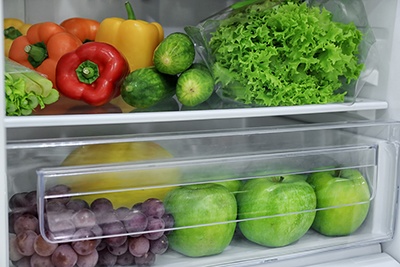By: Jacqueline Gomes, RDN, MBA
Spring is in the air and it’s the perfect time for a refrigerator clean out! When we think of spring-cleaning we usually think of closets and turning over our winter wardrobe to our more desirable warm weather clothing. However, spring-cleaning your diet should be part of your plan and here are 7 steps to get you started!

- Dump the old stuff: Yup, you know that moldy cheese, shriveled up lemon, decomposed – what is that anyway? Out with the old and in with the new!
- First in first out: A simple and effective system is “FIFO”, First In, First Out. When you arrive home from the grocery store, bring older items that need to be used first towards you and the newer items in the back of the fridge. Always look for expiration dates.
- Stock your fruit & veggie drawer: Finally, spring has sprung and there is an abundance of fresh produce to prove it! What’s in season? Check out Broccoli, Apricots, Collard Greens, Mango, Snow peas and white asparagus just to name a few. Try to purchase just enough for the week and restock on a weekly basis to maintain freshness.
- Stay hydrated: Stay hydrated with plenty of water each day. If you prefer a flavorful alternative, think spa water – toss a few sliced cucumber and lemons into a large pitcher and enjoy!
- Keep leftovers safe: Remember that cooked foods will remain safe to eat for a limited number of days. Not sure what to toss and when? Here’s a list:
- Cooked foods such as meatballs, roasted chicken, casseroles, etc.: 4 to 5 days
- Hard Cheeses: 3 to 4 weeks; but softer cheese like Brie about a week.
- Deli meats: 3 to 5 days
- Shellfish: 2 to 3 days max.
- Raw Veggies: hang on to these healthy treats for about 4 days.
- Fresh Fruit: eyeball it, as soon as its ripened eat it, once it starts to decompose you’re better off tossing it or wash and freeze.
- Frozen Foods: Not sure how long that frozen pork chop has been in there? Blame poor labeling and lack of planning. Always label your frozen foods with item name and date. Try to keep frozen foods like chicken and fish in a separate area; it will be easier to identify foods you can defrost for dinner. Keep these items for about 2 to 3 months.
- Pre-prep in the fridge: Use the refrigerator to your advantage; get in the habit of prewashing lettuce and fresh herbs like parsley when you arrive home from the grocery store. Store in a plastic baggie with a paper towel to absorb moisture – you’ll be more likely to eat these foods if they are pre-washed. Pre-prepping breakfast the night before is a great way to save time in the morning.
Chicken with Sugar Snap Peas & Spring Herbs
Quick-cooking chicken cutlets are paired with an elegant but easy light sauce of sugar snap peas and artichoke hearts. This dish can be made without the sprouted beans, but is especially delicious with them—if you have extras, try them on a salad.
Ingredients:
- 1 cup reduced-sodium chicken broth
- 1 teaspoon Dijon mustard
- ½ teaspoon salt
- Freshly ground pepper to taste
- 2 teaspoons plus 1 tablespoon flour, divided
- 1 pound thin-sliced chicken breast cutlets
- 1 tablespoon extra-virgin olive oil
- 8 ounces sugar snap peas, cut in half (2 cups)
- 1 14-ounce can quartered artichoke hearts, rinsed
- ¼ cup sprouted beans, (see Note), optional
- 3 tablespoons minced fresh herbs, such as chives, tarragon or dill
- 2 teaspoons champagne vinegar, or white-wine vinegar
Directions:
- Whisk broth, mustard, salt, pepper and 2 teaspoons flour in a small bowl until smooth.
- Sprinkle both sides of the chicken with the remaining 1 tablespoon flour. Heat oil in a large nonstick skillet over medium-high heat. Cook the chicken in two batches, adjusting heat as necessary to prevent burning, until golden, about 2 minutes per side. Transfer the chicken to a plate; tent with foil to keep warm.
- Stir the broth mixture and add to the pan along with snap peas, artichoke hearts and sprouted beans (if using). Bring to a simmer, stirring constantly. Reduce heat to maintain a gentle simmer and cook until the snap peas are tender-crisp, 3 to 5 minutes.
- Return the chicken to the pan, nestling it into the vegetables, and simmer until heated through, 1 to 2 minutes. Remove from heat; stir in herbs and vinegar.
Note: Sprouted beans, not to be confused with bean sprouts, are beans that have just barely sprouted—they look like a bean with a tiny fiber attached (rather than the more fleshy-looking sprouts commonly used in Asian cooking). Eat raw in salads or add to cooked dishes; they’re an excellent source of fiber and protein. Look for them in the produce section near other sprouts.
Recipe: Eatingwell.com
